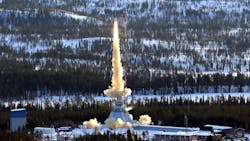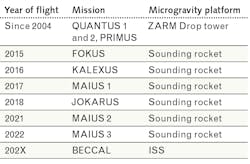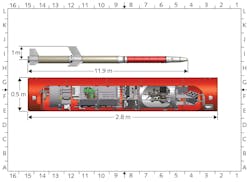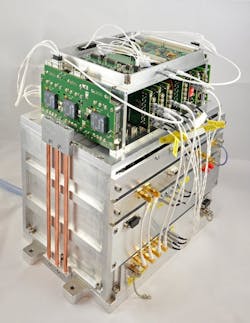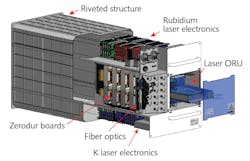Laser systems enable quantum technology in space
Quantum technology is currently one of the hottest topics in science, with atomic sensors taking a significant role in advancing developments. Atoms are a core component in quantum sensors and devices such as frequency references, ultrahigh-precision atomic clocks, magnetometers, and atom interferometers for inertial sensing and gravity measurements.
As well as their applied uses, atom interferometers are of particular interest to physicists for exploring fundamental physics such as measuring the universality of free fall (performing a quantum version of Galileo’s leaning tower of Pisa experiment). Atom, or matter-wave, interferometers are the atomic analogue of the more familiar light-based interferometers. Wave-particle duality is exploited such that the wave nature of atoms can be controlled and directed by light pulses.
As with light interferometers, it is important to use a monochromatic source—lasers for light interferometers, or a Bose-Einstein condensate (BEC) for an atom interferometer. A Bose-Einstein condensate is an exotic state of matter that occurs when atoms (more specifically bosons) are cooled below a critical temperature (on the order of nano-Kelvins), at which point the atoms “condense” into a single quantum state of wavefunction. Or, in other words, they have the same (de Broglie) wavelength, or “color.”
BECs are challenging to produce, but have almost become commonplace in physics labs around the world. However, taking them out of the lab and into the field is another matter. To generate a BEC, one must have an ultrahigh vacuum, atomic sources, stabilized single-frequency lasers, precise magnetic field and microwave generation, sophisticated control electronics, and, last but not least, reliable software to control such a complex system in real time with high precision.
The sensitivity of these atom interferometers is increased by increasing the time between beamsplitter light pulses, but the need for the atoms to be falling under gravity can limit this time. To overcome this, some experiments use 10-m-tall “fountains”; another approach is to remove gravity altogether. By building an experiment that can operate on a microgravity platform, one can increase these measurement times by an order of magnitude. However, it’s not as simple as putting a lab experiment in a rocket—the experiment must also be reduced in size and ruggedized so that it can survive the heavy mechanical loads at launch.
Testing platforms: Drop tower, sounding rocket, zero-gravity flights
Taking a cold atom experiment out of the lab and into microgravity requires significant developments to ensure components such as lasers, optics, and electronics are as small as possible and are able to withstand the environmental challenges of a launch. The progress in this process is measured as Technology Readiness Level (TRL).1 NASA developed TRLs in the 1970s to assess the maturity of a technology. TRL 1 of a technology denotes “basic principles observed and denoted”, while TRL 9 is awarded to “actual system flight proven through successful mission operations.”
In addition to the technological challenges of building a system that can withstand launch loads, one must choose a microgravity platform that is suitable for the TRL of both the experiment and the budget.
Although perpetual microgravity is the ideal, it is unfortunately the hardest to achieve, as the highest TRL levels are required. Fortunately, there are several platforms that are easier to access than launches to the International Space Station (ISS) or integration in a satellite. Platforms such as drop towers, parabolic flights, and sounding rockets have provided experimental opportunities for decades.
The ZARM drop-tower (Bremen, Germany) has hosted cold atom experiments for many years (see Fig. 1). This 146-m-tall tower allows for a microgravity (or free-fall) time of 4.74 s, during which the payload drops through the 110 m evacuated tube inside the tower. In a catapult configuration, in which payloads are thrown upward before falling, this time can be extended to about 9 s. Nevertheless, there are limits to the number of drop-tower launches per day due to the time taken to evacuate the tower when a payload is loaded.Other cold atom experiments have been demonstrated on zero-gravity parabolic aircraft flights, such as the Zero-G Airbus A310 operated by CNES subsidiary Novespace (Mérignac, France).
Small is beautiful: integrated laser systems
One example of a TRL-increasing development is the evolution of laser systems required for a space mission with cold atom experiments. Such lasers for cooling and trapping have been developed at the Ferdinand-Braun-Institut, Leibniz-Institut für Höchstfrequenztechnik (FBH; Berlin, Germany) and used in a sequence of missions, achieving higher TRL step by step. Their partners at the Humboldt-Universität zu Berlin (HUB; also in Berlin) are taking the lead for laser system integration. Other partners like Leibniz-Universität Hannover (Hannover, Germany) and Johannes Gutenberg-Universität Mainz (Mainz, Germany) contributed electronics and other photonic modules.
Micro-integrated diode-laser modules are at the center of the systems for trapping and cooling atoms. A typical diode-laser module as developed at FBH delivers more than 1 W at 780 nm out of a 40 g module. Shock testing has been conducted up to 1.500 g (with g here being standard gravity) and the lifetime can be up to 100,000 h mean-time-to-failure (MTTF). They were tested for temperature changes from -55° to 85°C in steps of 2 K/min.Optical frequency reference payloads
The subsequent JOKARUS mission targeted the comparison of a laser-based iodine frequency reference with a separate optical frequency comb. Figure 5 shows the JOKARUS payload developed for a sounding rocket mission. The system operated fully autonomously and demonstrated the suitability of automated frequency stabilization of a frequency-doubled 1064 nm ECDL to a molecular transition in iodine. Furthermore, it performed a frequency comparison measurement with an optical frequency comb, a separate experiment on the FOKUS II mission during the space flight.Up into space
The long time scales possible in low-Earth orbit are obviously beneficial for microgravity experiments. The ISS, for example, combines long-term access to a microgravity and a habitable environment; maintenance can even be performed by crew. Additionally, the operational acceleration requirements are lower than for experiments operating on platforms such as a sounding rocket. For the ISS, an experiment must “simply” survive launch mechanical loads, and experiments are largely protected from the harsh radiation and environmental conditions found in noncrewed satellites. However, the planning phase of such experiments can easily exceed 10 years, and competition is very strong for the limited space and resources that the station can provide.
In May 2018, the Cold Atom Lab (CAL) was launched to the ISS by a team at the Jet Propulsion Lab (Pasadena, CA). CAL’s goals include the study of quantum matter in microgravity, particularly involving BECs and ultracold atoms in novel geometries not possible on Earth due to the effects of gravity. As reported in Nature in June 2020,7 the team has successfully generated rubidium (87Rb) BECs. Novel cooling processes allowed for the creation of larger BECs in orbit than on Earth, thus demonstrating the benefits of microgravity for ultracold atom experiments. This early success paves the way for more complex experiments and investigations. CAL was further upgraded in January 2020 to add capabilities for atom interferometry.
BECCAL: Joining forces for a binational multi-user facility
The next generation of ultracold atom apparatus is already in preparation. In the Bose-Einstein Condensate and Cold Atom Laboratory (BECCAL), German and American scientists will join forces via a cooperation between NASA and DLR, the German Aerospace Center. Just as CAL currently does, BECCAL will lead to a multi-user and multipurpose ultracold apparatus onboard the ISS. Scientists from many research institutes and universities across Germany are working together to design and build the new apparatus before it is launched by NASA to the ISS.
BECCAL is expected to launch in the coming years. The facility will exploit the experiences of previous German and American missions to enable the exploration of a multitude of new experimental directions. Compared to previous experiments, it is designed to offer higher atom numbers, increased cycle rates, more complex trapping strategies, and improved atom-interferometry capabilities. Via 87Rb and 41K BEC production, quantum degenerate gases of 40K, and mixtures of potassium and rubidium isotopes, users will be able to study complex quantum gas phenomena, test fundamental physics, and prototype sophisticated interferometry and quantum information procedures.8
As for MAIUS, JOKARUS, and many of the other experiments discussed here, the success of BECCAL is reliant on the design and production of robust, compact, and complex laser systems. In fact, this is the most ambitious project yet: fitting 16 lasers, the required optics, and control electronics for an incredibly complex machine into less than 113 liters, along with ensuring a greater than three-year lifetime (see Fig. 6).And then?
Experiments on the ISS are already designed for remote operation, but there is always someone there to replace a burnt fuse, if we may use a simplified picture. The next development step would require fully remote operation; for example, on a satellite at a geostationary orbit some 36,000 km above ground.
Another application path would be in smaller satellites. Figure 7 shows the iQube Module, an integrated optical reference laser system with a rubidium vapor cell for cold atom experiments. This module was developed in a joint project between HU Berlin and the National University of Singapore (NUS), supported by the Berlin University Alliance. Microintegration was done at FBH. In conjunction with an optical frequency comb, which can be used as an optical-to-microwave frequency divider, such modules could be used in compact and simple vapor-cell-based clocks.The integration of complex technology including monochromatic laser systems has enabled the step-wise qualification of cold-atom experiments for space flights. The integration will further progress, leading to fist-sized units for space; this technology will likely be used in Earthbound applications in the near future.
REFERENCES
1. See https://go.nasa.gov/3qJpXp6.
2. A. Wicht, M. Krutzik, and A. Thoss, “Quantum sensing is gaining (s)pace,” Laser Focus World, 54, 1, 83–86 (2018); https://bit.ly/LFW-Thoss-Quantum.
3. M. Schiemangk et al., Appl. Opt., 54, 17, 5332–5338 (2015).
4. C. Kürbis et al., Appl. Opt., 59, 2, 253–262 (2020).
5. B. Barrett et al., Nat. Commun., 7, 13786 (2016); https://doi.org/10.1038/ncomms13786.
6. V. Schkolnik et al., Appl. Phys. B, 122, 217 (2016); https://doi.org/10.1007/s00340-016-6490-0.
7. D. C. Aveline et al., Nature, 582, 193–197 (2020); https://doi.org/10.1038/s41586-020-2346-1.
8. K. Frye et al., arXiv (Dec. 10, 2019); https://arxiv.org/abs/1912.04849.
About the Author
Andreas Thoss
Contributing Editor, Germany
Andreas Thoss is the Managing Director of THOSS Media (Berlin) and has many years of experience in photonics-related research, publishing, marketing, and public relations. He worked with John Wiley & Sons until 2010, when he founded THOSS Media. In 2012, he founded the scientific journal Advanced Optical Technologies. His university research focused on ultrashort and ultra-intense laser pulses, and he holds several patents.
Andreas Wicht
Head, Joint Lab Laser Metrology at Ferdinand-Braun-Institut
Andreas Wicht heads the Joint Lab Laser Metrology at the Ferdinand-Braun-Institut, Leibniz-Institut für Höchstfrequenztechnik (Berlin, Germany).
Markus Krutzik
Group Leader, Optical Metrology Group at Humboldt-Universität zu Berlin
Markus Krutzik is a group leader of the Optical Metrology Group at Humboldt-Universität zu Berlin (Berlin, Germany).
Victoria Henderson
Post-Doctoral Researcher, Humboldt University of Berlin
Victoria Henderson is a Post-Doctoral Researcher at Humboldt University of Berlin (Berlin, Germany).


